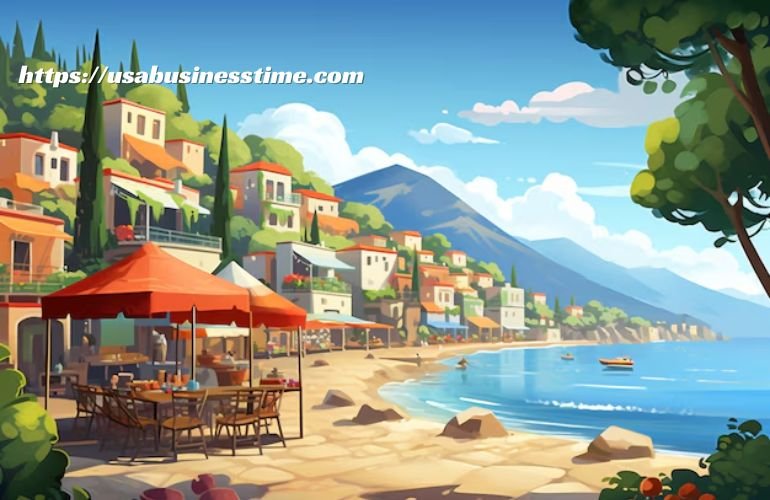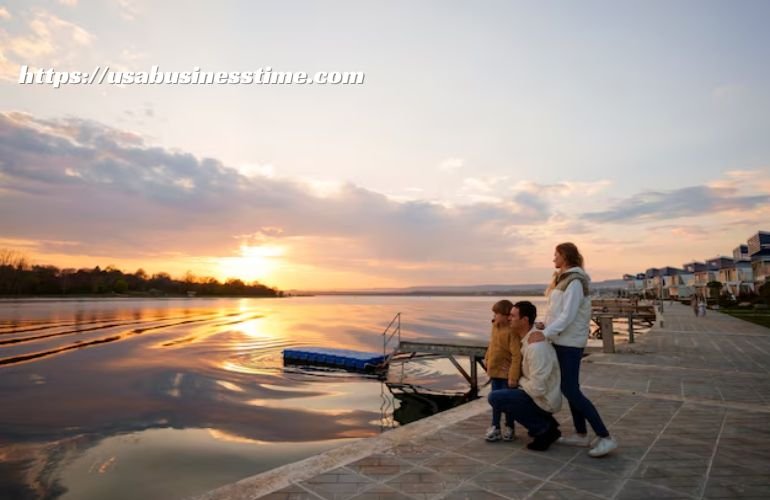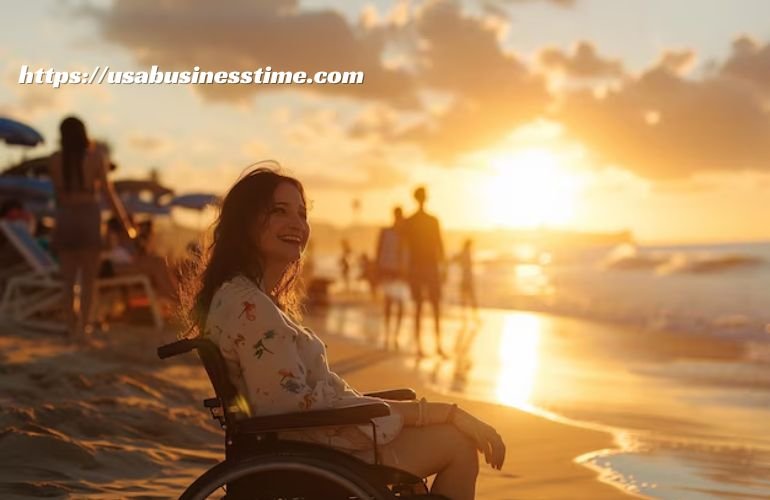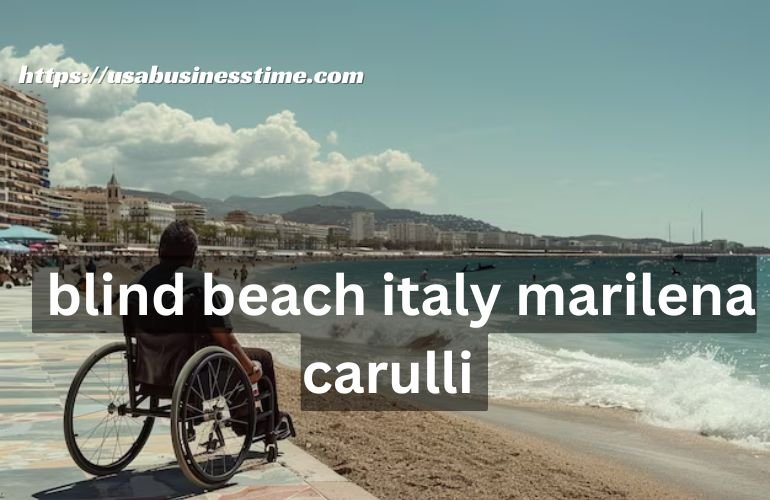Blind Beach, Italy, stands as a remarkable destination, breaking barriers in coastal accessibility. Crafted with inclusivity at its core, this unique beach destination offers a multisensory experience that opens up Italy’s beautiful coastlines to all, especially the visually impaired. At the heart of this initiative is Marilena Carulli, whose vision has transformed Blind Beach into a haven where nature, community, and accessibility meet. This article explores her journey, the beach’s groundbreaking features, and the broader impact on accessible tourism. Discover how Blind Beach is reshaping the experience of Italy’s coastline for every visitor.
Table of Contents
The Visionary Behind Blind Beach: Marilena Carulli’s Journey to Inclusivity
Marilena Carulli has always believed that everyone should be able to enjoy nature’s beauty, regardless of their physical abilities. Growing up along Italy’s stunning coastlines, she noticed the lack of accessible spaces for visually impaired visitors. This observation turned into a passion, driving her to create a place where accessibility and relaxation blend seamlessly. She envisioned a space that doesn’t simply accommodate people with disabilities but welcomes them with thoughtful design and a holistic approach.
Her journey was fueled by countless stories of individuals who couldn’t fully experience the beach due to physical or sensory limitations. Listening to these stories motivated her to push beyond traditional limitations, challenging the way beaches and natural spaces were designed. Carulli wanted more than basic accessibility—she wanted a sensory experience where textures, sounds, and scents could be enjoyed by all.
Blind Beach became her answer to these challenges. Through extensive planning and partnerships with local architects, disability advocates, and community leaders, Carulli crafted an environment that prioritized sensory experience. Features like tactile pathways, gentle sound cues, and Braille signs create a natural environment where visually impaired visitors can navigate the space with ease, independence, and confidence.
The impact of Carulli’s work goes beyond Blind Beach, as she has become a key figure in Italy’s inclusive tourism movement. Her dedication has inspired others to think creatively about accessibility, setting a standard for inclusive spaces. Her journey from coastal admirer to accessibility advocate highlights the power of empathy and vision in creating meaningful change. Carulli’s work reminds us that a shared commitment to inclusivity can transform public spaces into destinations where everyone feels a true sense of belonging.
Location and Features of Blind Beach, Italy
Blind Beach is located along Italy’s Amalfi Coast, a region celebrated for its stunning cliffs, vibrant Mediterranean waters, and historic charm. While the Amalfi Coast has long attracted travelers from around the world, Blind Beach sets itself apart with a layout designed to be accessible to all. The beach provides a sanctuary where visually impaired visitors can explore and enjoy the coastline without barriers, thanks to an array of innovative features.

One of the standout elements is the tactile pathway that winds across the beach, offering a physical guide that enhances navigation. The pathway’s surface changes subtly underfoot, helping visually impaired visitors recognize different zones, such as the entrance, seating areas, and shoreline. Each part of the pathway is thoughtfully integrated to maintain the natural feel of the beach while providing effective, accessible guidance.
Auditory cues add to the experience, with gentle sound markers placed strategically around the beach. These cues help visitors locate specific areas, like restroom facilities or relaxation zones, with ease. Soft background sounds, reminiscent of ocean waves, provide an immersive experience that allows visitors to connect deeply with the natural surroundings.
For those needing guidance, Braille signs and tactile maps offer essential information about facilities and safety guidelines. Visitors can use these signs to orient themselves, making Blind Beach a welcoming environment where independence is encouraged. The beach also offers special guide ropes, which serve as a simple yet effective way to assist visitors in moving confidently between areas.
In addition to sensory features, Blind Beach is equipped with well-designed accessible facilities, including wheelchair-friendly paths, accessible restrooms, and shaded seating areas. The seating zones cater to different needs, allowing visitors to relax comfortably. These facilities reflect a commitment to comfort and inclusivity, creating a space where all guests can enjoy their time by the sea.
The design of Blind Beach thoughtfully combines tactile, auditory, and physical elements that invite everyone to experience the beauty of Italy’s coast. By prioritizing accessibility without compromising the beach’s natural appeal, Blind Beach offers a serene escape for all visitors, showing how creativity and empathy can transform a location into a fully inclusive destination.
Innovative Accessibility and Sensory Enhancements
Blind Beach goes beyond traditional accessibility, offering sensory features that allow visitors with visual impairments to connect fully with the beach environment. This inclusive approach focuses on enhancing the beach experience through the senses of touch, sound, and spatial awareness, creating an atmosphere that feels both natural and immersive.
One of the key elements is a tactile pathway system that guides visitors safely across the beach. The textures underfoot subtly shift, signaling different zones—entrance, seating, shoreline—without the need for additional assistance. This design prioritizes independence, giving visually impaired visitors the freedom to explore at their own pace. Each section of the path is crafted to blend into the natural surroundings, ensuring that accessibility doesn’t disrupt the beach’s aesthetic appeal.
Adding to the tactile experience, Blind Beach has incorporated sound cues at key points around the area. These auditory markers, which gently guide visitors to restrooms, seating, and shorelines, help to create a mental map of the beach. This subtle audio design blends into the coastal soundscape, enhancing the experience without overwhelming the senses. For those seeking a relaxing day by the sea, the combination of ambient beach sounds and directional cues creates a harmonious setting.
Braille maps and informational signs add another layer to the sensory-rich environment. These provide essential details about facilities, safety protocols, and designated paths, allowing visitors to get oriented and move freely. With Braille signage placed at strategic points, the beach offers a safe yet empowering space where visitors can gain familiarity with their surroundings.
Another practical feature includes the use of guide ropes placed along walking routes. These simple tools offer an extra touchpoint for those who may want additional guidance as they move from one area to another. The ropes are positioned to fit naturally into the landscape, serving as reliable guides without disrupting the beach’s visual appeal.
Accessible seating and facilities complete the thoughtful design. The seating areas are equipped to cater to all guests, with shaded spots available for added comfort. Ramps and accessible restroom facilities make the beach inclusive for all visitors, including those who use wheelchairs or have mobility challenges.
Through these innovations, Blind Beach has set a high standard for inclusive tourism. The sensory enhancements offer a multisensory experience that prioritizes both comfort and independence, ensuring that every visitor can truly engage with the environment. The design reflects an understanding of diverse needs, making Blind Beach a space where accessibility is seamlessly integrated into the natural beauty of Italy’s coastline.
A Model of Inclusive Coastal Tourism
Blind Beach has quickly become a model for inclusive tourism in Italy, showing that thoughtful design and accessible features can open up public spaces to all. Located in a region well-known for its scenic beauty, Blind Beach does more than attract visitors; it sets a new standard in hospitality for individuals with disabilities. By putting accessibility at the forefront, the beach has positively impacted Italy’s tourism sector, encouraging other destinations to consider similar inclusive practices.
The local community has been an essential part of Blind Beach’s success. By engaging nearby residents, businesses, and local government officials, Marilena Carulli created a space that values everyone’s input. Community members have contributed ideas, offered insights, and helped maintain the beach’s facilities. This collaboration has made Blind Beach not only accessible but also deeply rooted in the area’s social fabric, benefiting both locals and visitors.
The beach’s influence extends beyond Italy, as it has become a reference point for inclusive tourism initiatives worldwide. Its popularity has inspired other coastal areas and natural sites to rethink accessibility in their spaces. Travel groups, advocates for the visually impaired, and accessibility experts have praised Blind Beach for its commitment to inclusivity, viewing it as a prime example of accessible tourism that doesn’t compromise on quality or enjoyment.
Blind Beach’s design also highlights a growing awareness of the importance of sensory experiences in accessible tourism. Many traditional accessibility solutions focus on functional access, like ramps and wide walkways. Blind Beach, however, considers the whole sensory experience, offering features like sound markers, tactile paths, and Braille guides that add depth to the visit. This holistic approach resonates with a wide audience, proving that accessible tourism can be enriching for all guests, not just those with specific needs.
By adopting a model that is both functional and enjoyable, Blind Beach challenges the standard assumptions about accessible spaces. It demonstrates that accessibility and beauty can coexist, enriching the travel experience for everyone. As word of Blind Beach’s achievements spreads, it encourages other tourist destinations to view accessibility as an opportunity rather than a constraint, paving the way for a future where every location is accessible and welcoming to all visitors.
Practical Guide for Visitors
Planning a trip to Blind Beach is straightforward, thanks to thoughtful design and practical amenities aimed at making every visitor’s experience enjoyable. Located along Italy’s stunning Amalfi Coast, Blind Beach can be reached by a combination of local transport options, including buses, taxis, and accessible transport services. For travelers arriving by car, parking options are available nearby, with accessible spaces for those with mobility needs.

For those visiting Blind Beach, choosing the right time is key to fully appreciating its serene atmosphere. The late spring and early autumn months offer pleasant weather without the height of summer crowds. This allows visitors to enjoy the beach’s facilities comfortably and engage with its sensory features without distractions. During peak seasons, arriving early in the day can provide a more relaxed experience as well as easier access to the shaded seating areas.
Blind Beach welcomes guests of all abilities with facilities tailored to diverse needs. The accessible pathways make moving around easy, while shaded seating areas offer spots to relax away from the sun. For visitors with visual impairments, tactile maps and guide ropes enhance their experience, providing spatial awareness and a sense of independence as they move around.
Packing essentials like sunscreen, hats, and light clothing will help visitors make the most of the beach’s natural beauty. For those who want to enjoy the sensory aspects more fully, leaving visual distractions like electronic devices aside can deepen the experience. The beach’s focus on tactile and auditory cues means that every visitor can connect with the environment through sound, touch, and scent, which creates a memorable day by the sea.
Accommodations near Blind Beach cater to varying preferences, with several accessible hotels and rentals that offer easy access to the beach and local attractions. Many of these accommodations are aware of Blind Beach’s special features and are equipped to support visitors with additional needs. Some establishments offer transport services directly to Blind Beach, making it easier for guests to reach this unique destination.
For a truly enjoyable visit, the support staff at Blind Beach are ready to assist as needed. Trained in accessibility and safety, they provide guidance with sensitivity and respect for each visitor’s preferences. Whether it’s helping with facilities or offering information about the sensory features, the staff’s attentiveness adds an extra layer of care to the experience.
With these practical considerations in place, Blind Beach is set up to provide a fulfilling and comfortable visit. This approach reflects the beach’s commitment to inclusivity and thoughtful design, creating an accessible space where everyone can enjoy Italy’s breathtaking coast.
The Social Impact of Blind Beach on Visually Impaired Visitors
Blind Beach has quickly become more than just a destination; it has grown into a community space that connects people through shared experiences and understanding. For visitors who are visually impaired, the beach represents a place where limitations are set aside, and the full beauty of Italy’s coastline can be appreciated through alternative sensory channels. This sense of belonging has resonated deeply, turning Blind Beach into a source of empowerment and relaxation for its guests.
Visitors with visual impairments often express how the beach provides a unique opportunity to enjoy nature independently. Features like tactile pathways, sound markers, and Braille signage offer a sense of spatial awareness that allows guests to move confidently throughout the space. Rather than needing constant guidance, they can explore the beach on their terms, which creates a feeling of freedom that is rare in traditional public spaces.
This inclusive design has encouraged more people with disabilities to travel, knowing that Blind Beach is a place where their needs are truly understood. The beach’s features go beyond functionality, creating an atmosphere where everyone feels invited to relax, enjoy, and connect with the environment. These aspects help to reduce the stress often associated with travel for those with visual impairments, as they know that their experience has been considered and that they can enjoy the beach without restrictions.
The impact of Blind Beach also extends to friends, family members, and caretakers who accompany visually impaired visitors. They, too, find joy in a place where accessibility is seamlessly integrated, allowing them to relax and enjoy quality time together without needing to worry about accessibility barriers. This shared experience builds deeper connections between visitors and fosters a sense of community that is rare in typical tourist settings.
Beyond the immediate experience, Blind Beach has sparked conversations on the importance of accessible tourism in Italy and beyond. Through this inclusive approach, the beach serves as a model, inspiring other destinations to rethink accessibility in a way that prioritizes independence and enjoyment. The positive response from visually impaired visitors and their families underscores how thoughtful design can shift public perception, highlighting the benefits of inclusive spaces for both individuals and the broader community.
The beach’s popularity has shown that accessible tourism does not only serve those with disabilities but enriches the experience for everyone by promoting a culture of inclusivity. Blind Beach’s model encourages the growth of similar projects around the world, providing people with disabilities the opportunity to engage fully with nature and share meaningful experiences with loved ones. In creating a space where accessibility and beauty meet, Blind Beach has become a testament to the power of inclusive design and its impact on individuals and communities alike.
Global Recognition and Inspiration
Blind Beach has attracted attention from around the world, not only as a destination but as a powerful example of accessible design. Its approach to inclusivity has become a reference point for tourism boards, urban planners, and advocates for accessible spaces globally. The beach’s innovative features and welcoming environment have set new standards, inspiring similar initiatives across Europe and beyond.
As word of Blind Beach’s achievements spreads, professionals in tourism and public spaces are beginning to rethink traditional approaches to accessibility. Conferences on inclusive design now often highlight Blind Beach as a case study, demonstrating how thoughtful planning can create spaces that offer both functionality and enjoyment for all. Its success has led other coastal regions and popular tourist destinations to explore ways to enhance accessibility, with many visiting the site to experience its design firsthand.
Blind Beach’s recognition extends to various organizations dedicated to disability rights and accessible tourism. These groups often point to Blind Beach as an example of how accessibility can foster a sense of dignity and independence. Articles, documentaries, and social media have showcased the beach, helping to bring more awareness to the importance of accessible tourism on a global scale. This exposure has encouraged other countries to adopt similar models, creating a ripple effect that amplifies the impact of Blind Beach far beyond Italy.
Inspiring destinations worldwide, Blind Beach has also influenced the development of standards in tourism policies. Several European and international tourism bodies are now considering updated guidelines based on insights from Blind Beach, supporting a future where accessible tourism becomes an industry norm. Its success has shown that inclusive spaces don’t only accommodate—they elevate the entire visitor experience, making destinations more attractive and enjoyable for everyone.
Beyond its structural impact, Blind Beach has encouraged a broader cultural shift. Visitors from various backgrounds have praised its approach, highlighting how inclusive spaces create a stronger sense of community. This positive feedback has reinforced the idea that inclusive tourism benefits all visitors, not just those with disabilities. By inspiring this shift in mindset, Blind Beach is helping to pave the way for a world where accessibility is integrated into the design of all public spaces, promoting equality and connection across diverse communities.
Blind Beach continues to serve as an inspiration, proving that inclusive tourism is not just possible but highly rewarding for destinations, communities, and travelers alike. Through its influence, the beach’s legacy extends worldwide, encouraging others to embrace a more inclusive vision for the future.
Looking to the Future: Evolving Visions and Accessible Tourism Trends
Blind Beach’s success has sparked a movement in accessible tourism, with Marilena Carulli’s vision continually expanding to meet the evolving needs of visitors. Her approach goes beyond just providing access; it embraces the idea that everyone should have the opportunity to enjoy a full, sensory-rich experience. As she looks to the future, Carulli is exploring new ways to enhance Blind Beach’s inclusivity while inspiring similar projects across the globe.

The future of Blind Beach includes plans to integrate emerging technologies that could enhance sensory experiences even further. Ideas like virtual guides and mobile apps with real-time audio descriptions are under consideration. These tools could allow visitors to receive personal guidance tailored to their needs, giving them even greater freedom to explore independently. Such advancements would not only add to the multisensory design of Blind Beach but also provide a model for other destinations seeking to enrich the experiences of all guests.
Carulli is also focused on strengthening partnerships with local and international organizations dedicated to accessible tourism. Collaborations with tech innovators, disability rights groups, and tourism boards are shaping new projects that aim to expand accessibility in travel. These partnerships are key to developing practical solutions that can be adopted by other destinations, both in Italy and around the world. The goal is to create a future where accessible tourism is not an exception but a norm, making travel more inclusive on a global scale.
Educational programs are another important part of the future vision. Carulli and her team are working on initiatives to raise awareness about the importance of inclusivity in tourism, targeting schools, universities, and tourism professionals. By educating the next generation of designers and hospitality experts, they hope to instill a mindset that prioritizes accessible design from the outset. These programs aim to spread knowledge and best practices, supporting a cultural shift towards creating spaces that are welcoming to everyone.
The evolution of Blind Beach aligns with a broader trend in tourism that values inclusivity as part of the visitor experience. Destinations worldwide are beginning to embrace the idea that accessibility is not only a necessity but a valuable enhancement to the experience they offer. The popularity of Blind Beach has shown that inclusive design attracts a wider range of visitors and fosters a more connected community.
Carulli’s work at Blind Beach is not just about creating a single accessible beach; it is part of a larger movement toward sustainable, inclusive tourism. By setting new standards and inspiring change, Blind Beach is paving the way for a future where all travelers can fully enjoy the wonders of our world. This future envisions a global tourism industry that recognizes accessibility as an opportunity to create spaces of beauty, connection, and shared experiences for all.
Conclusion
Blind Beach, Italy, represents a meaningful shift in the world of tourism, where accessibility and natural beauty coexist to create an experience that invites everyone to enjoy the coastline without limitations. Marilena Carulli’s vision has crafted a place where people with diverse abilities can connect with the sea, the sand, and the sounds around them in ways previously inaccessible. This beach has not only become a sanctuary of inclusivity but has also set a global standard for accessible travel destinations. By embracing sensory enhancements, community involvement, and future-forward initiatives, Blind Beach serves as a model of what tourism can become—where everyone feels welcome, valued, and free to explore.











